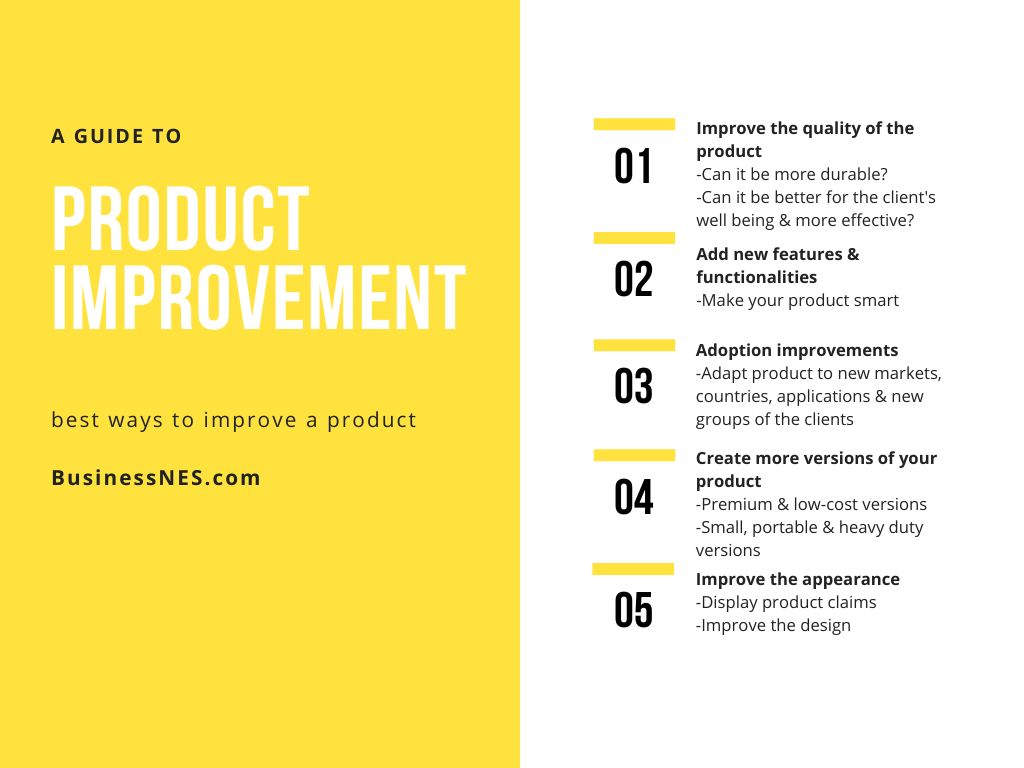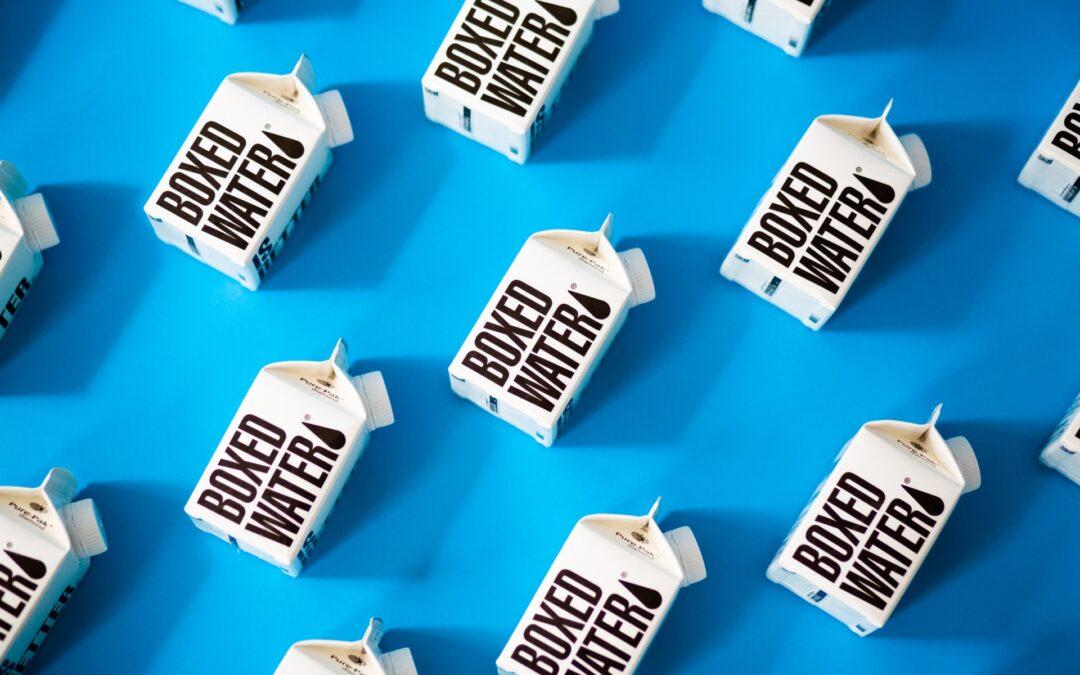In the following article, we have prepared a summary of the best ways to improve a product along with product improvement examples. We’ve compiled the best ways of improving product quality and effective strategies for new product adoption.
Product improvement is the process of introducing practical changes to a product that increase the product’s attractiveness and result in new customers and a better perception of the product in the marketplace.
BEST WAYS TO IMPROVE A PRODUCT
1. Add new features & functionalities
New better features that will be useful and attractive to people. Adding new features is very risky and should only be done when you are sure the changes will have a positive effect. For this purpose, it is advisable to ask your consumers beforehand what they think about such changes and what they need.
2. Improve the quality of the product
For example, a product that is made of a better quality material, a product that is more durable, a product that is organic, healthier and planet-friendly, a product that works twice as fast as other versions on the market, removing what people dislike most about the product (it is often a good idea to read your customers’ feedback on the product and note what is most often criticized – if possible it is worth removing it).
3. Adoption improvements
Adoption improvements are aimed at attracting customers who are not currently interested in your product. Adjust the product to the needs of the consumer from a given country or demographic group, or to given trends in the market.
4. Frequency improvements – make people use your product more frequently
Frequency improvements are aimed at increasing the frequency with which customers use a given product or how often they buy it. Such improvements may e.g. cause that a client will use a given application or website more often (e.g. as a result of placing additional materials on the website which will be of value to the users), or that clients will more often buy a given product e.g. drinks or crisps in which one can find prize codes as a part of a promotion.
5. Improve the appearance
Appearance has a huge impact on how customers perceive the product. It is important that the offered product is extremely attractive in terms of design. Product features such as color, size, font must match properly and cannot look cheap.
6. Create different versions of your product
Often the best way to improve a product is to offer different versions tailored to the needs of different customers. In this way, we allow the customer to choose for themselves the version they like best (e.g. small, mobile, portable, large, heavy duty, for children and for adults, limited edition). Offering many different versions of a product can be worthwhile for a wide range of product categories. From clothing, food, beverages and furniture to electronics and vehicles.
7. Change the form of the product
A great example of such a product is boxed water. Everybody knows bottled water and how difficult it is for a new company to stand out in this niche. However, water in cartons is something unique that many people have never tried before and it attracts attention and arouses interest. Another example of a change in the form of a product could be, for example, a minimalistic design of a product (reducing to a minimum everything that is not the essence of the product and that can be got rid of).
8. Improve the production process
Invest in machinery – If your products are created primarily by people rather than machines, there is a greater risk of errors, mishaps, defects and incorrect products.
Investing in high quality machinery significantly reduces the number of products made with defects.
A good impact on improving production also comes from improving your company’s organisation, as well as educating and training your employees.
9. Make your product easier to use
The average customer prefers uncomplicated products that are as easy to use and intuitive as possible. Nowadays, customers (especially the younger generations) want to get what they want quickly and without undue difficulty. Therefore, when improving a product, ask yourself: how can I make this product faster, easier and more intuitive? This principle applies to almost all products on the market, including everyday products, apps, electronic devices and even books (texts that are too complicated written in difficult sentences are less readable). Make your product quick, easy, intuitive and less time-consuming.
10. Increase the parameters to the maximum
This is one of the simplest yet most effective marketing tactics to improve your product or business. Examples of such successful tactics are the world’s deepest pool (link), or the most expensive pizza in the world (link). Why the above examples? Because they are known practically only for the fact that they broke records and offered maximum new experiences to customers.
Creating a product that breaks some kind of record or offers new extremes naturally attracts attention, creates excitement and makes the product famous for its extreme performance. Journalists and the media love to write about such products and they easily get famous on the Internet. Besides, they are very easy and effective to advertise (imagine this advertisement “the biggest in the world…, or the most expensive in the world…).

11. Adjust product to special applications
A good way to reach more customers and stand out above the competition is to offer a product tailored for special applications. People are often looking for a product tailored specifically for, e.g. children, sick people, the elderly, or one that is waterproof, heatproof, ultra-quiet, that has an extra-long shelf life, or that is ultra-durable, eco-friendly or pet-friendly. There are indeed many such special niches. It’s an effective way to break through with a new brand if you offer something like this that isn’t yet on the market.
12. Improve your product to be a smart product
Smart products are the second generation of the products we are all familiar with. We all know lamps, but few of us know smart lamps that automatically adjust light output and color. Likewise, everyone knows refrigerators, but few know smart fridges that monitor the amount of food in your fridge themselves and order food from the store themselves when they need it. A good way to change your product into the smart product is creating an app integrated with your product and making the way your product works more automated and convenient.
13. Make your product more efficient
Efficiency is one of the most important characteristics of a good product. Improving efficiency comes down to achieving maximum productivity with minimum wasted effort or expense. An efficient product will be produced and will operate using the minimum amount of resources such as time, materials, or energy.
14. Add product claims & certificates of quality on the package of your product
An effective way to increase product sales is to place product claims (e.g. “cook in 3 minutes” or “organic product”) in a visible way on the package, which will emphasize the high quality of the product, justify its higher price and attract more customers.
15. A new approach to solving a common problem
People love to make their lives easier, so when they see a new product that solves a common problem they are eager to buy it. Examples of such a problem-solver could be a bottle head for thick syrups or oils, which makes it so that the bottle does not get dirty when pouring this liquid and the liquid does not drip from it. Another example of such a product could be a shirt that does not crease and does not need to be ironed. Such an improvement of a product may also relate to the convenience of its packaging.
16. Get inspired by your competitors
This is one of the basic strategies for product improvement. We can often learn a lot from our competitors, sometimes even from smaller companies. When analyzing competitors’ products, pay attention to what they offer, which of their products are the most popular and why.
17. Mix your product with a complately different product (2 in 1)
Sometimes combining two desirable products or functions in one product yields excellent results. People love to make their lives easier, which is why two-in-one or multitool products are often very popular. To come up with such a product idea, it’s worth considering under what circumstances your product is used, when, where and by whom. A great example of such a product is a solar power bank with a flashlight. As you know power banks are used outside the home, often in harsh conditions, so combining these 3 functions (charger, power bank and flashlight) into one is an idea that has brought success to brands like UYAYOHU (available on Amazon).
18. Offer premium version of your product
According to the theory of the Veblen good, some products are more readily purchased if they are more expensive and sufficiently luxurious for those buying them to show their status. A Veblen good is a type of luxury good for which the demand increases as the price increases. The higher prices of Veblen goods may make them desirable as a status symbol in the practices of conspicuous consumption and conspicuous leisure (the snob effect). Examples of such products are, for example, luxury waters (worth up to $1,000 a bottle!), luxury wines, luxury clothes, food or sport cars.
19. Bind the product to something viral
This is a very interesting way to create a popular product. Examples of such products include selfie ring lights created specifically for social media such as TikTok or Instagram. These devices are designed to fit perfectly with the needs of social media stars. Another example of linking a product to something popular is when big brands organize or sponsor events such as festivals or sporting events (e.g. Redbull co-creating well-known extreme sports events, or well-known brands organizing music festivals).
20. Create a uniquely distinctive advertisement for your product
This tactic may not be about improving the quality of your product, but it has a huge impact on how your product will be perceived and associated. One example of such attractive ways to advertise a product is to use the most innovative forms of advertising such as advertising your products in the metaverse or using robots.
To maximize the success of your products don’t forget also:
- In eCommerce -make sure to offer better notifications and more attractive appearance, also user experience should be as good as possible (clear, simple, intuitive), filtering options are also recommended.
- Various types of product testing, including AB testing is a good way to find best improvements for the product.
- Social media presence – it is critical nowadays for most of the niches. Smart social media campaigns can have tremendous impact on your brand.
- SEO (search engine optimization) – optimisation of websites to make your products more visible in search engines.
- SEM (search engine marketing) – paid search engine marketing (like Google AdWords).
- Reduce costs, there where it’s possible.
- Offer a cheap version of the product – sometimes in opposite to the premium version of a product it is very profitable for a brand to offer a cheaper version of a product (like Apple offering in the previous years cheaper models of their popular iPhones).
HOW TO IDENTIFY THE MOST IMPORTANT FIXES A PRODUCT NEEDS?
1. Be open to customer feedback, especially negative feedback. Customers often articulate in reviews the biggest flaws of the product, and what they think is missing. Eliminating these flaws is one of the priority improvements which should be considered.
2. When you launch a new product, gather feedback from your users and carefully analyze what they say and what they like and dislike. It is very important at the initial stage of the product to listen to the feedback. One of the most effective ways to analyze customer opinions is to conduct surveys, interviews with customers, as well as asking about the opinions of customers who have purchased our product.
3. Evaluate how customers use and misuse your product. Analyze what customers say about your product and how they see it compared to your competitors.
4. Ask the question “how likely is it that you would recommend us to a friend or colleague?”
5. Measure all the possible aspects of the impact of what you do – measure the impact of the changes you make to your product
6. Analyze top selling products of your competitors what do they have that your product doesn’t have?
OTHER BEST WAYS TO MAKE A PRODUCT SUCCESSFUL
- Sometimes best way to improve a product is to make it cheaper and remove all the extra features which aren’t important for most of the clients. Customer-based pricing sometimes can help you beat the competition.
- Create a YouTube / TikTok channel where you wil be showing in a very interesting way the applications of your products and explain how to use them together with letting people better understand your product and the value and opportunities associated with owning your product.
- When you do a new product launch, gather feedback from your users and carefully analyze what they say and what they like and dislike. It is very important at the initial stage of the product to listen to the feedback. – interviews, surveys.
- The support team must be fast helpful and very friendly – this is very important for almost all products, and especially for ecommerce.
- Following the guidelines of the Quality Management System (QMS) and International Standards Organization (ISO).
PSYCHOLOGICAL TRICKS TO SELL MORE
A very effective way to improve product sales is to use psychological tricks. These tricks are used by many of the biggest brands around the world. Some of the most popular psychological sales tricks include:
-
- Bundling – i.e. selling several products in a bundle slightly cheaper than if the customer bought them all separately (e.g. buy a $999 TV and a $350 cinema set for $1249). Or buy 5 pairs of socks for $20, each pair of socks costing $5 individually.
- Micropayments – a sales trick that works particularly well for games and apps. It involves, for example, offering an app for free, but in the app there are paid items or premium add-ons that you have to pay for.
- Price anchoring – involves influencing customers’ cognitive bias by comparing the current price of a product to the much higher price of a competitor’s product (for example, comparing another product costs $300 and ours only costs $189!). Price anchoring also often boils down to offering a product at a discount (e.g. previously this product cost as much as $300 and now only $189). In this way, customers perceive the product as a bargain and are more likely to buy it.
- Shrinkflation – is to offer the same product for the same price, but a slightly smaller size, or slightly lower quality. Doritos, for example, are a well-known example – offered until recently in a 9.75 oz. pack, they have started to be sold at the same price in a 9.25 oz. pack. – a reduction of five chips. This is a psychological trick used by many companies (especially popular in times of inflation), so that customers who are used to the old price do not see much difference and continue to buy the product willingly without noticing the change.
- Decoy effect – Imagine a bottle of soda sold at three prices: small (300ml) for $3, medium (750ml) for $7 and large (1 litre) for $8. It will be obvious to many customers that it is not profitable for them to buy the small bottle so they will choose the larger or largest bottle because it will seem more profitable to them.
- FOMO (Fear Of Missing Out) – It boils down to making the customer fear they will miss out on a product or opportunity. Examples of FOMO are online stores where it is stated that the last 1, 2 or several pieces of a product are available. Information such as this makes the customer more decisive in making a purchase, not wanting to miss out on the last product.
Read also: TOP 30 Competitive Advantage Strategies
EXAMPLES OF IMPROVED PRODUCTS WITH UNIQUE FEATURES
When thinking about how to improve a product, it is worth asking “what makes the most popular products so popular?”. Often it is because of their uniqueness and usefulness, as in the case of the following items that make life easier:
A portable dishwasher for apartments without one
How to improve a product like a popular dishwasher? Offer it’s mobile version like this one available on Amazon!
A sleek wallet phone case
A great example of solving two problems with one product. Like this one available on Amazon.
Seasonlife Clip On Strainer for Pots & Pans – Universal Pasta Strainer
This is another great example of a product that solves a problem of many people. There are many similar everyday problems that still need a solution. A clip on strainer like this one is available on Amazon.
Pop-the-Top Beer Bottle Opener
A good example of how to improve a product is this beer opener. It has been optimized to the max, making it ultra-convenient, as well as having an interesting design. A professional beer bottle opener like this one is available here on Amazon.
And how do you think? How to improve a product and what are the most effective ways to do it? Share your knowledge and ideas with us in the comments section below!
Recommended Articles

TOP 40 Fire-Related Business Ideas to Start in 2024
When we think about fire, it's often about its dangers or the essential role it plays in our daily lives, from cooking to keeping us warm. Yet,...

Is Apple About to Face Tough Times?
Apple, a paragon of innovation and a titan in the tech industry, stands at a critical crossroad. The fiscal year of 2023 unveiled a stark reality:...

Top 30 Business Ideas Near Highway & Guide
If you're considering starting a business near a highway and are on the hunt for the most profitable ventures, you've come to the right place....

TOP 25 Catering Business Ideas for 2024
If you're looking to start a business in the food industry, exploring catering business ideas for 2024 might be the perfect path for you. The catering world offers a wide range of opportunities, from small, intimate gatherings to large-scale events, allowing for...

30 Types of Clothing Stores – Shop Definitions & Examples
In this article, we have compiled a list of the 30 most common types of clothing stores. At first glance, it might seem that a clothing store is simply a place where clothes are sold, suggesting that there wouldn't be many variations among them. However, the reality...




